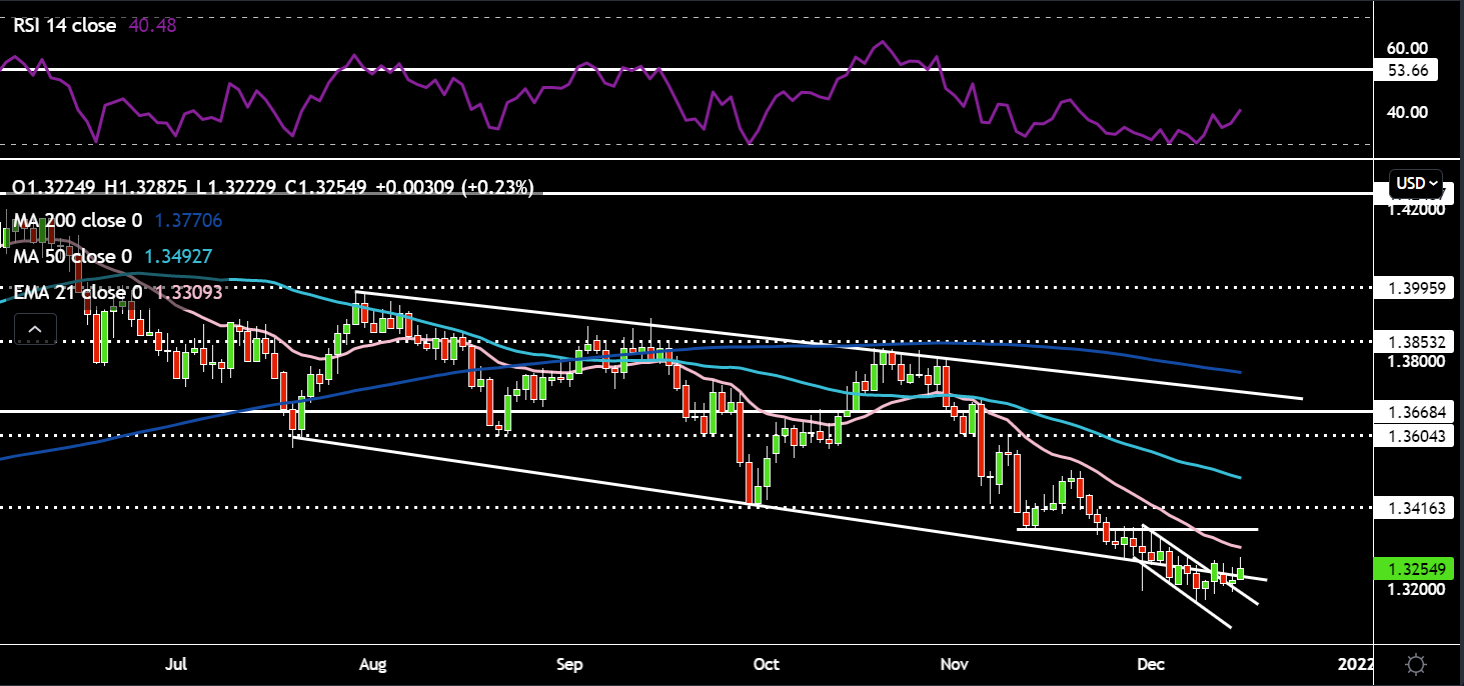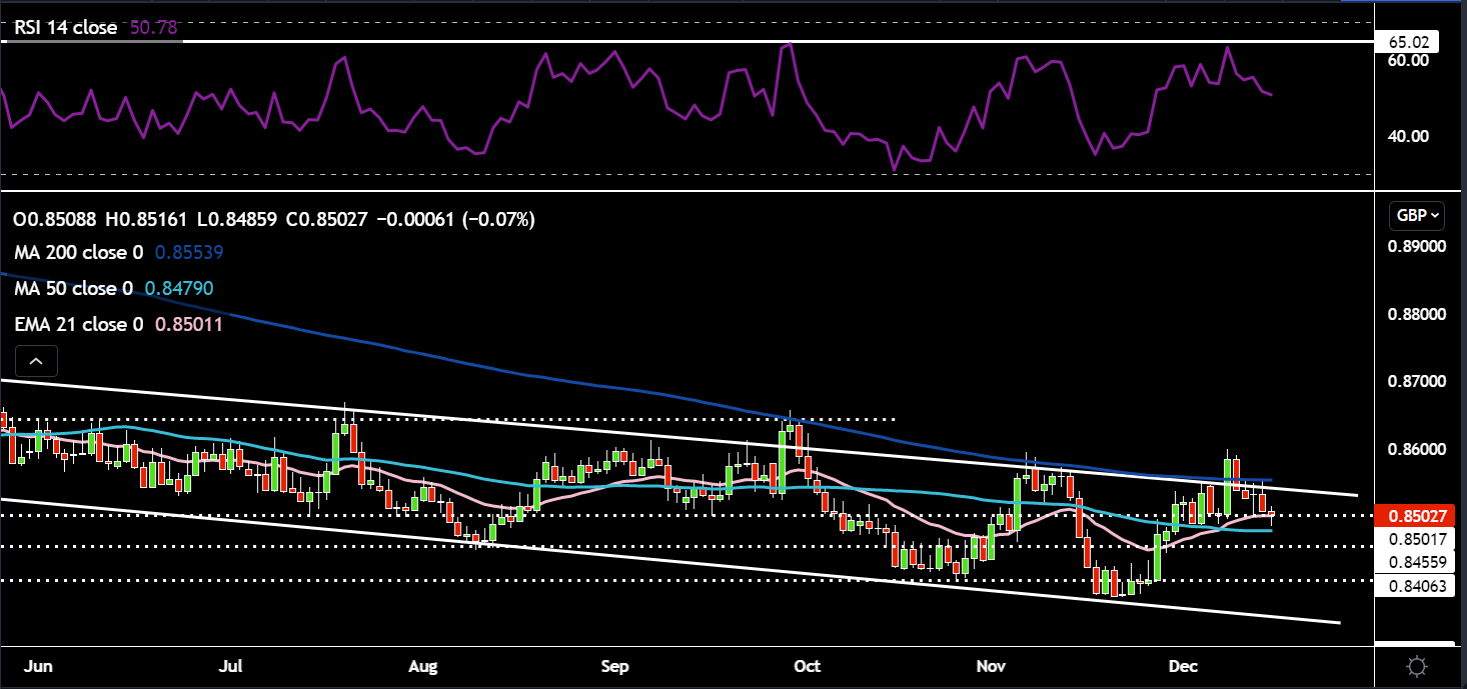- English
- 简体中文
- 繁体中文
- ไทย
- Tiếng Việt
- Español
- Português
- لغة عربية
The Bank of England are back to deliver their interest rate policy decision tomorrow at 12pm GMT. No surprises like which unfolded at the November meeting are expected to be thrown the market’s way as the consensus clearly now expects a delay to the 15bps hike. The BoE have gone from one uncertainty to the next – labour data to now omicron. The announcement of Plan B restrictions was the nail in the coffin for any moves by the BoE come Thursday. If even one of the most hawkish members of the MPC (Saunders) stated there could be advantages to waiting for more data on how the omicron variant will impact the U.K. economy before raising rates then we can expect the more dovish/neutral members to be hesitant on the rate hike front. This is quite clearly a patient committee which sees “value in waiting for additional information”. It costs them less to wait and fall temporarily behind the curve as opposed to jumping the gun too early (remember monetary policy has a lag between implementation and visible effects). At the last meeting the interest rate vote was 7-2, with Saunders and Ramsden leading the hawkish charge, however, with the latest commentary by Saunders could we see this meeting’s vote at 8-1 instead? This combined with any softening in the policy statement tone could have dovish implications for money market expectations around February’s meeting, potentially applying some pressure on GBP. Some other historical precedents provide further support for a hold at this meeting – since gaining independence the BoE has never hiked at a December meeting with Christmas round the corner as well as preferring to take policy action at meetings that coincide with monetary policy reports and press conferences.
Traders focus will be shifting to February’s meeting as they try to assess whether the BoE will hike by 15bps vs 25bps or hold again. This really does depend on the damage caused by omicron over the next 2 months. The UK with their higher natural immunity and the rapid ramp up in booster jabs (41% of population 12+ and 86% of over 60 population triple jabbed) should be able to avoid harsher lockdowns like we’ve seen previously, limiting the economic impact. This is very much dependent on the number of hospitalizations and deaths (busiest time of year for the NHS in Winter as it is). Case data should have peaked by the time of the next meeting (if it follows previous trends), with the BoE having more information at their fingertips to evaluate whether economic risks (how does the labour market hold up) from omicron will be on a downward trajectory. Continuing with the medium-term outlook, the SONIA curve indicates a bank rate of around 1% by end 2022. This is quite aggressive and creates the risk of a dovish repricing in those expectations if there are any speedbumps throughout next year. This would be a headwind for sterling.
Labour, Inflation & GDP data:
We received the first official employment report with the distortionary effects of furlough removed. It went fairly smoothly and I think bar omicron this would have been enough for the BoE to move. Average earnings (excluding bonuses) which feeds through to wage pressures was above consensus at 4.3% vs 4% exp, the employment gains of 149k was below the 225k anticipated, however, the claimant count showed a good decrease and the unemployment rate was lower than the 4.3% expected as well as tracking below the BoE’s forecast of 4.5%. Taking into account record vacancies and these figures the labour market looks healthy and is heading in the right direction.
Moving onto the price stability side of the equation. Headline and core inflation both substantially beat the market’s expectations and with core (strips out volatile items) at 4% it is now the highest reading since 1992. The surge above 5% at a headline level has arrived earlier than many economist and the Bank themselves expected. Upon closer inspection, services inflation remains weak and price pressures are still largely being driven on the energy and goods components. The concern for the BoE of higher inflation is an unanchoring of expectations and second round effects such as wages rising – this would create more persistent inflation and could prove difficult lowering it back to the 2% target within the Bank’s ideal timeframe. Looking at OIS pricing post this inflation drop it seems rate markets have got a tad ahead of themselves with pricing for a hike tomorrow now at 74%. This could actually see sterling weaken if a hold is announced.
GDP data out Friday almost was flat from a MoM perspective as it creeped up by a paltry 0.1%, this is quite significantly down from the 0.6% seen in September as well as the consensus of 0.4%. This leaves the UK economy 0.5% smaller than pre-covid levels. It remains to be seen how the economy will fare going forward as restrictions could be increased as key personnel involved in these decisions produce ominous warnings - CMO Whitty warned that UK hospitals could be overwhelmed in four weeks. Given the UK’s economy is heavily skewed towards services, tighter restrictions are a definite risk to the recovery.
GBPUSD:
GBPUSD found a pre-meeting bid after the inflation numbers and saw price move above both the mini descending channel and back into the main descending channel. I think a good upside target is the round number 1.33 around the 21-day EMA. Above that 1.335 (white horizontal line) would be the next go to. On the downside, a break of 1.32 would be key bringing the 8 December lows of 1.316 into play. The RSI flirted with oversold and has risen 10 points to around 40.

EURGBP:
EURGBP has failed again to show proper follow through as it breached its upper trend line and the 200-day SMA. The RSI resistance line at 65 proved again to be a useful tool in guiding the sustainability of the move. Price is now hovering just above its 50-day SMA and right on top of its 21-day EMA. Targets wise on the upside again moves into the 200-day SMA and trend line would be important (around 0.855) and then on the downside the 50-day SMA will prove important with moves below there bringing 0.845 into play.

Related articles
Ready to trade?
It's quick and easy to get started. Apply in minutes with our simple application process.
The material provided here has not been prepared in accordance with legal requirements designed to promote the independence of investment research and as such is considered to be a marketing communication. Whilst it is not subject to any prohibition on dealing ahead of the dissemination of investment research we will not seek to take any advantage before providing it to our clients.
Pepperstone doesn’t represent that the material provided here is accurate, current or complete, and therefore shouldn’t be relied upon as such. The information, whether from a third party or not, isn’t to be considered as a recommendation; or an offer to buy or sell; or the solicitation of an offer to buy or sell any security, financial product or instrument; or to participate in any particular trading strategy. It does not take into account readers’ financial situation or investment objectives. We advise any readers of this content to seek their own advice. Without the approval of Pepperstone, reproduction or redistribution of this information isn’t permitted.
.jpg)

